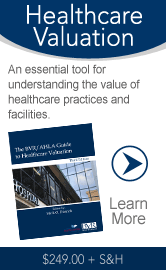 |
 |
Issue #29-1 | December 4, 2014

Be careful with rules of thumb when valuing healthcare entities When valuing a healthcare entity for M&A or divestiture purposes, rules of thumb are often cited, such as a multiple of sales or EBITDA. The trouble is, rules of thumb don’t tell the whole story. Plus, you typically see a range of multiples. Where in the range are we? For example, endoscopy suites typically are valued at 3x to 6x EBITDA, points out Donald DeGrazia (Gold Gerstein Group LLC), a business valuation expert. That’s a wide variation, so you need to investigate where the entity falls within that range. It will depend on a number of factors, he says, such as reimbursement rates, profitability, number of ORs, competition, regulation, and whether a certificate of need (CON) is required. A rule of thumb metric may ignore two of the most critical drivers of business value: cash flow and growth. Also, the metric may be stale and out of step with recent trends. When to use: Rules of thumb do have a place, however. They can give you an indicator of what drives value in a particular business, according to DeGrazia, who spoke at the recent AICPA Forensic and Valuation Services Conference. And they’re also good to use as a sanity check on a full-blown valuation you receive from an expert. If the expert’s opinion of value is far different from what the rules of thumb say, ask for the reasons why. High court will uphold insurance subsidies, says HHS chiefThe Supreme Court will soon hear arguments in King v. Burwell, one of several cases in which plaintiffs argue that the federally run health insurance exchanges do not have the authority to distribute subsidies to help individuals pay for coverage. The outcome of this case could have a huge impact on the financial picture of healthcare providers. Prediction: During a recent speech in Dallas, Health and Human Services (HHS) Secretary Sylvia Mathews Burwell said she is confident that the high court will rule for the administration and allow every eligible enrollee to receive subsidies, not just those in certain states. "The United States Congress did not intend that some states, and citizens of only some states, would benefit from this and residents of other states would not," she says, according to a report from WOAI News in San Antonio. Under the ACA, each state must establish a healthcare insurance exchange. States have the option to either form their own state-run exchange or partner with the exchange run by the federal government. To date, only 17 states have set up their own exchanges. Some experts feel that, if the court determines the subsidy does not apply to federal exchanges, more states will set up their own. Hospitals starting to leverage big data to save money After years of spending tons of money on IT to satisfy new law requirements for electronic health record (EHR) systems, hospitals are now reaping the rewards, according to an article in the Harvard Business Review. One-year payback: For example, HBR cites ThedaCare, a healthcare system in Wisconsin, and its use of clinical business intelligence (CBI), a system that collects and analyzes data on a real-time basis to be used by frontline clinicians. ThedaCare, with seven hospitals and 25 clinics, spent $750,000 on the system and saved $850,000 in overtime costs in its first year. The ThedaCare Center for Healthcare Value, an independent nonprofit educational institute, has worked with 18 organizations in North America to implement a CBI strategy. Trading performance and multiples for healthcare-services sector The S&P Healthcare Services Index has increased by 4.6% over the three-month period of July 2014 to September 2014, thus outperforming the S&P 500, according to the October 2014 Healthcare Sector Update from Duff & Phelps. The best performers were acute care hospitals (up 20.8%), contract research organizations (up 10.7%), and home care/hospice (up 10.6%). The worst performing sectors were care management/TPA (down 18.2%), diagnostic imaging (down 15.4%), and consumer-directed health and wellness (down 11.1%), says the report. Latest multiples: The current median LTM revenue and LTM EBITDA multiples for the healthcare-services industry overall are 1.51x and 10.9x, respectively. The sectors with the highest valuation multiples include consumer-directed health and wellness (4.11x LTM revenue, 25.3x LTM EBITDA), other services (1.79x LTM revenue, 21.3x LTM The report also provides data on the pharmaceutical/medical devices/life sciences sectors. Cap rates down in senior Capitalization rates have decreased significantly for each segment of the senior care M&A market since 2013, according to recent data in the 2014 Senior Care Acquisition Report, published by Irving Levin Associates. Bull market: For the four quarters ended Sept. 30, 2014, assisted living cap rates were down 70 basis points, from 8.7% to 8.0%. They were down 60 basis points, from 8.5% to 7.9%, for independent/assisted living. Also, they were down 70 basis points, from 13.0% to 12.3%, for skilled nursing. “The availability of equity and cheap debt, plus an influx of new buyers, has been driving prices up and cap rates down in a seniors housing bull market that is seeing more M&A transactions than ever before,” says the report. The average price per unit for assisted living facilities is up 30.5%, from $150,600 to $196,600; up 28.8%, from $164,000 to $211,300 per unit, for independent/assisted living; and up 7.0%, from $73,300 to $78,400 per bed, for skilled nursing. Is your hospital’s imaging center Contraction and consolidation are in full swing in the imaging center market, so hospitals have had to take a hard look at their own imaging operations. Out of step: In a more competitive imaging environment, hospitals have finally woken up to the fact that they are too expensive, according to Douglas Smith (Integrated Medical Partners LLC). Also, consumerism has hit the healthcare sector, so patients are shopping around. A hospital-owned, provider-based imaging center with out-of-market pricing has become a “dinosaur,” says Smith, speaking in a recent BVR webinar. Hospitals and healthcare systems are aggressively acquiring or joint venturing with imaging centers in their market. They have decided that the imaging business is theirs alone, and “they are not going to stand to have any competitors in their area,” says Smith. There’s money to be made in this business but just not as much as before, he says. Learn more: To listen to an archived version of the webinar Valuing Imaging Centers, click here. How salary increases for hospital executives stack up In 2014, the average base salary for hospital and health system executives rose an average of 3.1% between 2013 and 2014, according to the 2014 Manager and Executive Compensation in Hospitals and Health Systems Survey from Sullivan, Cotter and Associates. CFOs of health systems saw the largest increase in compensation (3.5%), as opposed to CFOs at independent or system-owned hospitals. CEOs at independent hospitals saw the largest average base salary increase (6.4%). Here’s how increases for C-suite execs stack up:
“Consolidation and integration within the health care industry continues to influence compensation and drive how executives are paid by both the level and manner of pay," says Kathy Hastings, Sullivan Cotter's executive compensation practice leader. Extra: Sixty-one percent of CFOs at struggling hospitals expect to be fired by 2016 because their revenue cycle management, staff, and solutions have been stuck in fee-for-service mode too long, according to recent Black Book survey results. Payment reform triggers population health management Most healthcare providers are taking a proactive stance in dealing with upcoming changes in payment models. One strategy is to implement population health management. The vast majority (80%) of respondents to a recent survey say that their organizations have launched some form of population health management program, up 7% from last year's survey. For insights, read a free download of Population Health: Are You as Ready as You Think You Are? from HealthLeaders Media. Price transparency cuts consumer healthcare spending If you shed some light on healthcare pricing, consumers will spend less, a new study in the Journal of the American Medical Association reveals. Educated consumers: Patients in a health insurance plan were given access to a pricing website that calculated out-of-pocket costs for various medical procedures. The authors of the study found that patients who used the website (searchers) spent 14% less for laboratory tests, 13% less for advanced imaging, and 1% less for clinician office visits than those who did not (nonsearchers). The searchers in the study had spent more than nonsearchers before using the website, so it appears that price transparency is the factor that drove the decrease in spending. Upcoming webinar on assessing physician compensation BVR has an ongoing Online Symposium on Healthcare Valuation, which focuses on the challenges inherent in valuations in medicine, life sciences, and healthcare. Next up in the series is Understanding Work RVUs, Collections, Hours and Other Data That Impact Physician Compensation (December 16), with Alan Simons (CliftonLarsonAllen LLP). Simons explains how to take advantage of the many resources available to assess physician compensation, as well as the many challenges associated with using those resources. |
|
||||||||||||||||||||||||||
Business Valuation Resources, LLC
1000 SW Broadway, Suite 1200, Portland, OR 97205
(503) 291-7963 | editor@bvhealthcarenews.com
bvresources.com/healthcare

